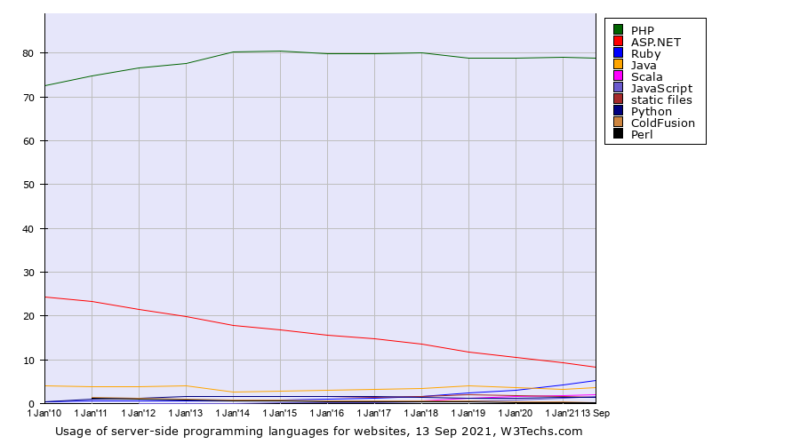recursive acronyms are forever —
Despite many infamous quirks, the server-side language seems here to stay.
Jim Salter
–

Enlarge / Ruby is the only server-side web language that experienced much growth over the last decade—and the closest remaining “threat” to PHP, despite having only 6.5 percent the presence.
The venerable web programming language PHP is a source of frequent complaints and frustration, but according to a report W3Techs released today, it doesn’t seem to be going away any time soon.
W3Techs’ web server survey looks for technologies in use by sites in Alexa’s top 10 million list; today’s report includes a year-on-year chart beginning with January 2010, running all the way through 2021. The survey only includes top sites not out of elitism, but as one part of its effort to avoid data-skewing returns from domain-parking services and spammers, which would otherwise dominate legitimate websites through sheer volume.
Within that dataset, the story told is clear. Apart from PHP—which held a 72.5 percent share in 2010 and holds a 78.9 percent share as of today—only one other server-side language ever broke a 10 percent share. That one competitor is ASP.NET, which held an impressive 24.4 percent share in 2010 but was down to 9.3 percent in January and 8.3 percent this month.
Amongst the small fry, the only truly impressive growth to be seen is in Ruby—which at 5.2 percent this month is still seeing continued uninterrupted growth in W3Techs’ survey. This might come as a shock if you’re mostly familiar with Ruby on Rails, which itself remains viable but seems to be on the decline in popularity.
There doesn’t appear to be any clear contender for PHP to worry about in W3Techs’ results, either—the inexorable decline of ASP.NET over the years hasn’t produced a significant boost in either PHP or any other single language.
In all likelihood, most of the “disappearing” ASP.NET sites already included some PHP—which would have resulted in a single site being counted twice in W3Techs’ results while having little or no impact on the other languages as ASP.NET services quietly deprecate.
Listing image by PavelVinnik / Getty Images

